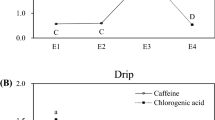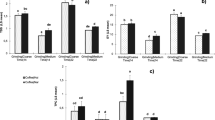Abstract
The aim of the present study was to evaluate the effect of preparation conditions of espresso coffee (EC) on the diterpenes profile. ECs were prepared from roasted and ground (R&G) Arabica coffee and analyzed for the content of cafestol and kahweol by liquid–liquid extraction followed by HPLC-DAD, as well as their lipid content. The main variables in the present study were as follows: the water quantity, the amount of coffee, the particle size, the percolation time, the water temperature and pressure. Average cafestol, kahweol and lipid content of R&G Arabica coffee were 467 ± 20 mg/100 g, 638 ± 33 mg/100 g and 15.1 ± 0.1 g/100 g, respectively. Although all parameters influenced the diterpenes content of ECs (21 samples), the particle size and water quantity were the most significant ones. It was possible to reduce the total diterpenes from 58.8 ± 0.7 mg/L (2.3 mg/40 mL) to 30.7 ± 0.8 mg/L (1.2 mg/40 mL) by varying the brewing conditions. The average extraction yield of diterpenes and lipids was in the range of 1.5–2.5 and 7.0–9.0 %, respectively. Regarding total cafestol and kahweol, very fine particles seem to be more desirable for the production of highly concentrated brew (2.3 mg/40 mL) with cafestol and kahweol extraction yields of 2.8 and 2.9 %, respectively, than other studied ECs. On the other hand, samples brewed at 70 °C exhibited lower diterpenes content (1.2 mg/40 mL) and diterpenes extraction efficiency (1.4 %) with respect to all other considered parameters. This study clearly shows that parameters for coffee brew preparation may be changed to modify the diterpenes content of ECs according to the desired purpose.



Similar content being viewed by others
References
Illy A, Viani R (2005) Espresso coffee: the science of quality, 2nd edn. Elsevier Academic Press, UK
Illy A (2005) Quality. In: Illy A, Viani R (eds) Espresso coffee: the science of quality, 2nd edn. Elsevier Academic Press, USA
Petracco M (2001) Technology IV: beverage preparation, brewing trends for the new millennium. In: Clarke RJ, Vitzthum OG (eds) Coffee: recent developments. Blackwell Science, UK
Nunes FM, Coimbra MA, Duarte AC, Delgadillo I (1997) Foamability, foam stability, and chemical composition of espresso coffee as affected by the degree of roast. J Agr Food Chem 45:3238–3243
Navarini L, Rivetti D (2010) Water quality for espresso coffee. Food Chem 122:424–428
Parenti A, Guerrini L, Masella P, Spinelli S, Calamai L, Spugnoli P (2014) Comparison of espresso coffee brewing techniques. J Food Eng 121:112–117
Scholz MBS, Pagiatto NF, Kitzberger CSG, Pereira LFP, Davrieux F, Charmetant P, Leroy T (2014) Validation of near-infrared spectroscopy for the quantification of cafestol and kahweol in green coffee. Food Res Int 61:176–182
Kitzberger CS, Scholz MB, Pereira LF, Vieira LG, Sera T, Silva JBJD, Benassi MT (2013) Diterpenes in green and roasted coffee of Coffea arabica cultivars growing in the same edapho-climatic conditions. J Food Compos Anal 30:52–57
Kӧlling-Speer I, Strohschneider S, Speer K (1999) Determination of free diterpenes in green and roasted coffees. J High Resolut Chrom 22(1):43–46
Speer K, Kölling-Speer I (2006) The lipid fraction of the coffee bean. Braz J Plant Physiol 18(1):201–216
Araújo JMA, Sandi D (2006) Extraction of coffee diterpenes and coffee oil using supercritical carbon dioxide. Food Chem 101:1087–1094
Urgert R, Essed N, van der Weg G, Kosmeijer-Schuil TG, Katan MB (1997) Separate effects of the coffee diterpenes cafestol and kahweol on serum lipids and liver aminotransferases. Am J Clin Nutr 65:519–524
Boekschoten MV, Evert G Schouten EG, Katan M B (2004) Coffee bean extracts rich and poor in kahweol both give rise to elevation of liver enzymes in healthy volunteers. Nutr J 3(7)
Lee KJ, Jeong HG (2007) Protective effects of kahweol and cafestol against hydrogen peroxide-induced oxidative stress and DNA damage. Toxicol Lett 173:80–87
Cavin C, Holzhäuser D, Scharf G, Constable A, Huber AA, Schilter B (2002) Cafestol and kahweol, two coffee specific diterpenes with anticarcinogenic activity. Food Chem Toxicol 40:1155–1163
Cárdenas C, Quesada AR, Medina MA (2011) Anti-angiogenic and anti-inflammatory properties of kahweol, a coffee diterpene. PLoS ONE 6(8):e23407
Wang S, Yoon YC, Sung MJ, Hur HJ, Park JH (2012) Antiangiogenic properties of cafestol, a coffee diterpene, in human umbilical vein endothelial cells. Biochem Biophys Res Commun 421:567–571
Cavin C, Holzhäuser D, Constable A, Huggett AC, Schilter B (1998) The coffee-specific diterpenes cafestol and kahweol protect against aflatoxin B1-induced genotoxicity through a dual mechanism. Carcinogenesis 19(8):1369–1375
Gloess AN, Schönbächler B, Klopprogge B, D‘Ambrosio L, Chatelain K, Bongartz A, Strittmatter A, Rast M, Yeretzian C (2013) Comparison of nine common coffee extraction methods: instrumental and sensory analysis. Eur Food Res Technol 236:607–627
Andueza S, Vila MA, de Pena MP, Cid C (2007) Influence of coffee/water ratio on the final quality of espresso coffee. J Sci Food Agr 87:586–592
Buchmann S, Zahm A, Kӧlling-Speer I, Speer K (2009) Lipids in coffee brews, impact of grind size, water temperature, and coffee/water ratio on cafestol and the carboxylic acid-5-hydroxytryptamides. Euro Food Chemistry XV, Copenhagen, Denmark
Andueza S, de Peña MP, Cid C (2003) Chemical and sensorial characteristics of espresso coffee as affected by grinding and torrefacto roast. J Agr Food Chem 51:7034–7039
Andueza S, Maeztu L, Pascual L, Ibáñez C, de Peña MP, Cid C (2003) Influence of extraction temperature on the final quality of espresso coffee. J Sci Food Agr 83:240–248
Caprioli G, Cortese M, Cristalli G, Maggi F, Odello L, Ricciutelli M, Sagratini G, Sirocchi V, Tomassoni G, Vittori S (2012) Optimization of espresso machine parameters through the analysis of coffee odorants by HS-SPME-GC/MS. Food Chem 135:1127–1133
Andueza S, Maeztu L, de Peña MP, Dean B, Bello J, Cid C (2002) Influence of water pressure on the final quality of arabica espresso coffee, application of multivariate analysis. J Agr Food Chem 50:7426–7431
Zhang C, Linforth R, Fisk ID (2012) Cafestol extraction yield from different coffee brew mechanisms. Food Res Int 49:27–31
Moeenfard M, Silva JA, Borges N, Santos A, Alves A Quantification of diterpenes and their palmitate esters in coffee brews by HPLC-DAD. Int J Food Prop. doi:10.1080/10942912.2014.933351
Illy E, Navarini L (2011) Neglected food bubbles: the espresso coffee foam. Food Biophys 6(3):335–348
Petracco M (2005) The cup. In: Illy A, Viani R (eds) Espresso coffee: the science of quality, 2nd edn. Elsevier Academic Press, USA
Pangborn RM, Trabue IM, Little AC (1971) Analysis of coffee, tea and artificially flavored drinks prepared from mineralized waters. J Food Sci 36:355–362
Petracco M (2005) Grinding. In: Illy A, Viani R (eds) Espresso coffee: the science of quality, 2nd edn. Elsevier Academic Press, USA
Sehat N, Niedwetzki G (1997) Coffee lipids: analysis of diterpene 16-O-methylcafestol as an indicator of admixing of coffee. In: McDonald RE, Mossoba MM (eds) New techniques and applications in lipid analysis. AOCS Press, USA
Roth K (2003) Espresso-ein Dreistufenpräparat. Chem unserer Zeit 37(3):215–217
Teo CC, Tan SN, Yong JWH, Hew CS, Ong ES (2010) Pressurized hot water extraction (PHWE). J Chromatogr A 1217:2484–2494
Masella P, Guerrini L, Spinelli S, Calamai L, Spugnoli P, lly F, Parenti A (2015) A new espresso brewing method. J Food Eng 146:204–208
Ratnayake WMN, Hollywood R, Grady E, Stavric B (1993) Lipid content and composition of coffee brews prepared by different methods. Food Chem Toxicol 3(4):263–269
Acknowledgments
This work was funded by FEDER funds through the Operational Programme for Competitiveness Factors—COMPETE, ON.2—O Novo Norte—North Portugal Regional Operational Program and National Funds through FCT—Foundation for Science and Technology under the projects: PEst-C/EQB/UI0511, NORTE-07-0124-FEDER-000025—RL2_ Environment & Health and SFRH/BD/79318/2011.
Conflict of interest
None.
Compliance with Ethics Requirements
This article does not contain any studies with human or animal subjects.
Author information
Authors and Affiliations
Corresponding author
Rights and permissions
About this article
Cite this article
Moeenfard, M., Silva, J.A., Borges, N. et al. Diterpenes in espresso coffee: impact of preparation parameters. Eur Food Res Technol 240, 763–773 (2015). https://doi.org/10.1007/s00217-014-2381-y
Received:
Revised:
Accepted:
Published:
Issue Date:
DOI: https://doi.org/10.1007/s00217-014-2381-y




